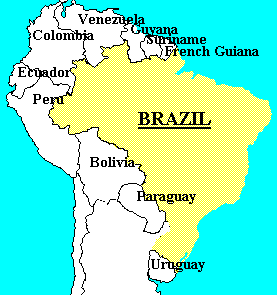
Return to * Top Ten *RIC Main Page * Background Info
Brazil
Background Information

Basic Indicators
| Polulation | 159 million |
| Pop. growth | 1.7 % p.a. |
| Land Area | 8.4 mill. sq km |
| GNP per capita | 2,970 current US$ |
| Life expectancy | 66.4 years |
ENVIRONMENT
There are five major regions in Brazil. The Amazon Basin, in the North, is the largest tropical rainforest in the world. It consists of lowlands covered with rain forest, criss-crossed by rivers. The Carajás mountain range contains one of the worlds largest mineral reserves, rich in iron, manganese, copper, nickel and bauxite. The economy is mainly extractive. The Northeastern "sertao" consists of rocky plateaus with a semiarid climate and scrub vegetation. Cattle raising is the main economic activity. The more humid coastal strip, situated on the “Serra do mar(Coastal Sierra), has numerous sugar cane and cacao plantations. In the Southeast, the terrain consists of huge plateaus bordered in the East by the Serra do Mar mountain range. The main crops are coffee, cotton, corn and sugar cane. The southern plateau, with sub-tropical climate, is the countrys main agricultural region, where coffee, soybeans, corn and wheat are grown. In the far South, on the Rio Grande do Sul plains, cattle raising is the main economic activity. Finally, the mid-West region is made up of vast plains where cattle raising predominates. With the devastation of the Amazon region, caused by unrestrained felling of trees, the habitats of many species have been destroyed.
THE SOCIETY
Peoples: Brazilians come from the ethnic and cultural integration of native inhabitants (mainly Guarani), African slaves and European (mostly Portuguese) immigrants. Arab and Japanese minorities have also settled in the Rio-Sao Paulo area. Contrary to what is commonly admitted, racial discrimination does exist and the groups fighting it are rapidly gaining strength.
Religion: most are baptised Catholic but there is considerable merging into syncretic Afro-Brazilian cults (macumba and umbbanda).
Language: Portuguese is the official and predominant language.
THE STATE
Official Name: República Federativa do Brasil.
Administrative Divisions: 26 States, 1 Federal District. Capital: Brasilia, 1,492,500 inhab. (1991).
Other cities: São Paulo 9,393,700 inhab.; Rio de Janeiro 5,473,900 inhab.; Salvador 2,070,300; Belo Horizonte 1,529,600 inhab.; Recife 1,297,000 inhab.; Porto Alegre 1,237,200 inhab.; Manaus 1,005,600 inhab. (1991).
Government: Fernando Henrique Cardoso, President since 1995. Bicameral legislature.
National Holiday: Sept. 7, Independence Day (1822).
Political Parties: Brazilian Social Democratic Party (PSDB), led by Senator Artur da Távora and President Fernando Henrique Cardoso; Party of the Liberal Alliance (PFL), led by Jorge Bornhausen; Party of the Brazilian Democratic Movement (PMDB), led by Luis Henrique da Silveira; Workers Party (PT), led by Rui Falcao; Peoples Reform Party (PPR), led by senator Espiridião Amin; Democratic Labor Party (PDT), led by Leonel Brizola; Brazilian Labor Party (PTB), led by Jose E. de Andrade Vieira; the Communist Party split into two groups: orthodox communists (PC), led by Oscar Niemeyer, and the Peoples Socialist Party, led by senator Roberto Freire. In addition, there are countless other minor national or provincial organizations.
Social Organizations: Workers are grouped together primarily in the Sole Group of Labor Unions (CUT), the General Confederation of Workers (CGT) and the Labor Union Forum. Many labor unions do not belong to any of these, preferring to remain independent. Movement of the Landless (MST), an association of workers without land whose agenda is agrarian reform in rural areas, and land for the construction of housing, in urban areas. National Union of Indigenous Peoples (UNI), an association of Brazils different indigenous groups. Pastoral Commission of the Earth (CPT) and Indigenous Missionary Council (CIMI), pastoral groups of the Catholic Church involved in social action in these areas. Defence Network of the Human Race (REDEH), an eco-feminist organization. "Torture Never More", state groups committed to the defence of human rights.
Armed Forces: 295,000 troops (1995). Paramilitaries: 243,000 Public Security Forces.
Source: World Guide 1997/98 courtesy of New Internationalist ![]()
Return to * Top Ten *RIC Main Page * Background Info